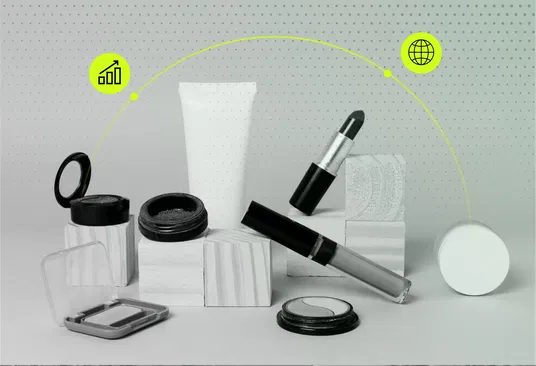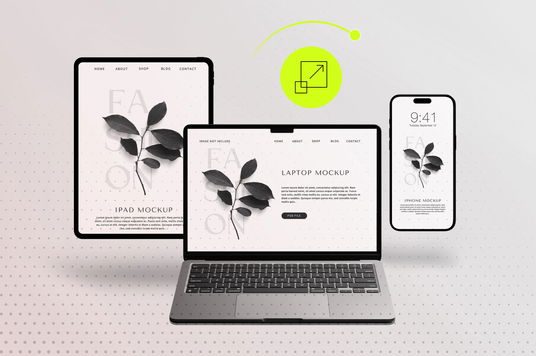Expanding Globally? What Beauty Brands Need to Know Before Scaling Online

- Global Beauty Market Opportunities
- International Tax Setup for Skincare Brands
- Cross-Border Ecommerce Logistics for Beauty Products
- Local Language Support for Cosmetic Websites
- Geo-Targeted Promotions for Global Beauty Stores
- Expanding Shopify and BigCommerce Store for Global Wellness Market
- Beauty Product Regulations by Region
- Global Payment Solutions
- Multi-Language Customer Support
- Implementation Roadmap
- Frequently Asked Questions
Global Beauty Market Opportunities
The global beauty and personal care market is experiencing unprecedented growth, with international ecommerce sales projected to reach $463 billion by 2027. For beauty brands looking to expand beyond domestic markets, the opportunity is massive—but so are the complexities.
Successfully scaling a beauty brand internationally requires more than just translating your website and shipping products overseas. It demands a comprehensive understanding of international tax setup for skincare brands, regulatory compliance, cultural preferences, and technical infrastructure that can support global operations.
"Beauty brands that successfully expand internationally see an average revenue increase of 150-300% within the first two years, but only 35% of brands that attempt global expansion achieve sustainable success without proper preparation."
— Global Beauty Commerce Report 2025
This comprehensive guide covers everything beauty brands need to know before scaling online globally, from technical requirements to regulatory compliance and market-specific strategies.
International Tax Setup for Skincare Brands
One of the most critical aspects of global expansion is establishing proper international tax setup for skincare brands. Tax compliance varies significantly across regions and can make or break your international expansion efforts.
VAT and Sales Tax Requirements
Different regions have varying tax structures that beauty brands must navigate:
🇪🇺 European Union VAT
EU VAT rates range from 17-27% for cosmetics. Brands must register for VAT in countries where they exceed €10,000 in annual sales. The One-Stop Shop (OSS) system simplifies multi-country compliance.
🇬🇧 UK VAT System
Post-Brexit UK requires separate VAT registration. Standard rate is 20% for most beauty products, with some exceptions for essential items like sunscreen (0% VAT).
🇺🇸 US Sales Tax
State-by-state compliance required. Economic nexus thresholds vary from $100,000-$500,000 in annual sales. Some states have specific cosmetics taxes.
🇨🇦 Canadian GST/HST
5% GST applies nationally, with additional provincial taxes. Beauty products are generally taxable, but some therapeutic items may qualify for exemptions.
Tax Automation Solutions
Manual tax calculation becomes impossible at scale. Implement automated tax solutions:
- Avalara: Comprehensive tax automation for global commerce
- TaxJar: US-focused with expanding international coverage
- Vertex: Enterprise-level global tax management
- Native Platform Solutions: Shopify Tax, BigCommerce Tax Services
💡 Pro Tip: Start tax compliance setup 3-6 months before launching in new markets. Some registrations can take weeks to process, and you'll need time to integrate tax calculation systems with your ecommerce platform.
Cross-Border Ecommerce Logistics for Beauty Products
Beauty products present unique logistical challenges for international shipping. Cross-border ecommerce logistics for beauty products requires careful consideration of product restrictions, temperature control, and customs regulations.
Shipping Restrictions and Regulations
Many beauty products face shipping restrictions due to their chemical composition:
⚠️ Restricted Items: Aerosols, nail polish, perfumes with high alcohol content, and products containing lithium batteries (LED devices) face significant shipping restrictions. Always verify restrictions before expanding to new markets.
Common Shipping Restrictions by Product Type:
- Aerosols & Pressurized Products: Prohibited on most air transport, limited ground shipping options
- Alcohol-Based Products: Perfumes, toners, sanitizers face restrictions based on alcohol percentage
- Liquid Products: Volume restrictions, special packaging requirements for international shipping
- Powder Products: May require additional screening, especially mineral makeup and setting powders
- Electronic Beauty Devices: Battery restrictions, CE marking requirements for EU
Temperature-Controlled Shipping
Many beauty products require temperature control during shipping:
🧴 Skincare Products
Serums, creams, and treatments with active ingredients may degrade in extreme temperatures. Consider insulated packaging for shipments over 3 days.
💄 Makeup Products
Lipsticks, foundations, and cream products can melt or separate in high temperatures. Summer shipping requires special consideration.
🌿 Natural & Organic Products
Products without preservatives are especially sensitive to temperature fluctuations and may require expedited shipping.
International Shipping Partners
Choose shipping partners with beauty industry experience:
- DHL Express: Excellent for beauty products, temperature-controlled options available
- FedEx International: Strong network, good for high-value beauty items
- UPS Worldwide: Comprehensive tracking, good for B2B beauty shipments
- Regional Specialists: Local partners often provide better last-mile delivery
Local Language Support for Cosmetic Websites
Effective local language support for cosmetic websites goes far beyond basic translation. Beauty is deeply cultural, and successful localization requires understanding local beauty standards, ingredient preferences, and shopping behaviors.
Cultural Beauty Preferences
Beauty standards and product preferences vary significantly across cultures:
🇰🇷 Korean Market
Focus on skincare over makeup, glass skin trends, multi-step routines. Emphasize ingredients like snail mucin, ginseng, and fermented extracts.
🇫🇷 French Market
Emphasis on natural ingredients, minimalist routines, and luxury positioning. French consumers value heritage and artisanal production methods.
🇧🇷 Brazilian Market
Strong focus on hair care, sun protection, and vibrant makeup colors. Natural ingredients from the Amazon are highly valued.
🇯🇵 Japanese Market
Precision in application, subtle enhancement, and innovative textures. Technology-driven products and seasonal collections perform well.
Technical Localization Requirements
Implement comprehensive localization systems:
- Content Management: Use headless CMS systems that support multiple languages
- SEO Localization: Research local keywords, beauty terms, and search behaviors
- Currency Display: Show prices in local currency with real-time conversion
- Date/Time Formats: Adapt to local conventions for shipping estimates and promotions
- Address Formats: Support local address structures and postal codes
✅ Localization Success: Beauty brands that invest in proper localization see 40-60% higher conversion rates in international markets compared to those using basic translation services.
Geo-Targeted Promotions for Global Beauty Stores
Implementing effective geo-targeted promotions for global beauty stores requires understanding local shopping behaviors, seasonal trends, and cultural celebrations that drive beauty purchases.
Regional Promotional Strategies
Tailor promotions to local market conditions and cultural events:
Seasonal Considerations by Region:
- Northern Hemisphere: Summer skincare focus (May-August), winter hydration emphasis (November-February)
- Southern Hemisphere: Reverse seasonal patterns, Christmas occurs during summer
- Tropical Regions: Year-round sun protection focus, monsoon season considerations
- Desert Climates: Extreme hydration needs, dust protection products
Cultural Shopping Events:
🛍️ Singles' Day (China)
November 11th - Largest shopping event globally. Beauty brands see 300-500% sales increases with proper preparation.
🎉 Diwali (India)
Festival of Lights - Major beauty shopping period. Focus on gold-toned makeup, traditional colors, and gift sets.
🌸 Golden Week (Japan)
Late April/Early May - Travel and celebration period. Promote travel-sized products and spring collections.
🎊 Carnival (Brazil)
February/March - Vibrant makeup and body products. Waterproof formulas and bold colors perform well.
Dynamic Pricing Strategies
Implement intelligent pricing that considers local market conditions:
- Purchasing Power Parity: Adjust pricing based on local economic conditions
- Competitive Analysis: Monitor local competitor pricing and adjust accordingly
- Currency Fluctuation: Build in buffers for exchange rate volatility
- Local Taxes: Display tax-inclusive pricing where expected by consumers
Expanding Shopify and BigCommerce Store for Global Wellness Market
When expanding Shopify and BigCommerce store for global wellness market, platform-specific considerations can significantly impact your success. Each platform offers different strengths for international expansion.
Shopify Global Expansion Features
Shopify provides robust international commerce capabilities:
🌍 Shopify Markets
Native multi-market management with automatic currency conversion, local payment methods, and market-specific pricing rules.
💱 Multi-Currency Support
Display prices in local currencies with automatic conversion. Supports 130+ currencies with real-time exchange rates.
🚚 Global Shipping
Calculated shipping rates, duty and tax calculation, and integration with international carriers.
🗣️ Translation Apps
Extensive app ecosystem for translation and localization, including Langify, Weglot, and native translation features.
Shopify Plus International Features:
- Expansion Stores: Create market-specific stores with shared inventory
- Advanced Markets: Sophisticated geo-targeting and market segmentation
- B2B Capabilities: Wholesale pricing for international distributors
- API Flexibility: Custom integrations for complex international requirements
BigCommerce International Capabilities
BigCommerce offers enterprise-level international features:
🏪 Multi-Storefront
Create region-specific storefronts with shared catalog and inventory management across all locations.
💳 Global Payments
Support for 65+ payment gateways including regional favorites like Alipay, iDEAL, and Boleto.
📊 Advanced Analytics
Market-specific reporting and analytics to track performance across different regions.
🔧 Headless Commerce
API-first architecture enables custom international experiences and integrations.
Platform Selection Considerations
Choose the right platform based on your expansion goals:
🎯 Platform Recommendation: Shopify excels for rapid international expansion with its Markets feature, while BigCommerce offers more flexibility for complex B2B international operations. Our beauty eCommerce development services can help you choose and implement the right platform for your global expansion strategy.
Beauty Product Regulations by Region
Navigating international beauty regulations is crucial for successful global expansion. Each region has specific requirements for product registration, labeling, and ingredient restrictions.
Major Regulatory Frameworks
🇪🇺 EU Cosmetics Regulation
Requires Responsible Person designation, CPNP notification, and compliance with banned/restricted ingredient lists. Safety assessments mandatory.
🇺🇸 FDA Regulations
Voluntary registration system, but strict labeling requirements. Color additives require pre-market approval. OTC drug claims need FDA approval.
🇨🇳 NMPA Requirements
Mandatory registration for imported cosmetics. Animal testing may be required for certain categories. Local agent required.
🇯🇵 MHLW Standards
Quasi-drug classification for functional cosmetics. Notification required for cosmetics, approval for quasi-drugs.
Common Compliance Requirements
- Ingredient Disclosure: Full INCI listing required in most markets
- Safety Documentation: Product safety reports and testing data
- Labeling Standards: Language requirements, warning statements, and mandatory information
- Import Licenses: Some regions require specific import permits for cosmetics
- Local Representatives: Many markets require local responsible persons or agents
⚠️ Compliance Warning: Regulatory violations can result in product seizures, fines, and market bans. Always consult with local regulatory experts before entering new markets. Budget 6-12 months for regulatory approval processes in major markets.
Global Payment Solutions
Offering local payment methods is crucial for international success. Beauty consumers expect familiar, trusted payment options in their local markets.
Regional Payment Preferences
🇨🇳 China
Alipay (54% market share), WeChat Pay (39%), UnionPay for cards. Mobile payments dominate with QR code integration essential.
🇩🇪 Germany
SEPA Direct Debit, Sofort, PayPal, and traditional bank transfers. Germans prefer secure, established payment methods.
🇧🇷 Brazil
Boleto Bancário for offline payments, PIX for instant transfers, and installment payments are extremely popular.
🇳🇱 Netherlands
iDEAL dominates online payments (60% market share), followed by PayPal and credit cards.
Global Payment Processors
Choose processors that support your target markets:
- Stripe: Excellent global coverage, supports 135+ currencies and local payment methods
- Adyen: Enterprise-focused, strong in Europe and Asia, unified platform
- PayPal: Trusted globally, good for markets where trust is crucial
- Worldpay: Strong in traditional markets, good for high-volume processing
Multi-Language Customer Support
Providing excellent customer support in local languages is essential for building trust and loyalty in international markets. Beauty customers often have specific questions about ingredients, application, and suitability for their skin type.
Support Channel Preferences by Region
💬 Live Chat
Preferred in North America and Europe. Implement with AI chatbots for 24/7 coverage and human escalation for complex beauty questions.
📱 WhatsApp Business
Dominant in Latin America, India, and parts of Europe. Enables rich media sharing for beauty tutorials and product demonstrations.
📧 Email Support
Still important globally, especially for detailed product inquiries and order issues. Ensure 24-hour response times in local languages.
📞 Phone Support
Critical in markets like Germany and Japan where phone support indicates trustworthiness and premium service.
Beauty-Specific Support Considerations
- Ingredient Expertise: Train support staff on ingredient benefits, contraindications, and allergies
- Skin Type Guidance: Provide personalized product recommendations based on skin concerns
- Application Instructions: Offer detailed usage guidance, especially for complex skincare routines
- Return Policies: Clear policies for opened beauty products, considering hygiene regulations
- Shade Matching: Support for color cosmetics, including virtual consultations
Implementation Roadmap
Successfully expanding globally requires a phased approach. Here's a proven roadmap for beauty brands scaling internationally:
Phase 1: Foundation (Months 1-3)
✅ Core Infrastructure:
- Set up international tax compliance systems
- Implement multi-currency and multi-language capabilities
- Establish shipping partnerships and logistics infrastructure
- Begin regulatory compliance research for target markets
Phase 2: Market Entry (Months 4-6)
🎯 Strategic Launch:
- Launch in 1-2 test markets with full localization
- Implement geo-targeted marketing campaigns
- Set up local customer support channels
- Monitor performance and gather customer feedback
Phase 3: Optimization (Months 7-9)
📊 Data-Driven Improvements:
- Analyze performance metrics and customer behavior
- Optimize pricing strategies based on market response
- Refine product offerings for local preferences
- Expand successful strategies to additional markets
Phase 4: Scale (Months 10-12)
- Market Expansion: Launch in 3-5 additional markets
- Advanced Features: Implement AR try-on, AI recommendations
- Partnership Development: Establish local influencer and retail partnerships
- Supply Chain Optimization: Set up regional fulfillment centers
"The most successful beauty brands approach international expansion as a marathon, not a sprint. Those that invest in proper foundation and take a phased approach see 3x higher success rates than brands that try to launch everywhere at once."
— International Beauty Commerce Study 2025
Ready to expand your beauty brand globally? Our specialized beauty eCommerce development services can help you navigate the complexities of international expansion and build the technical infrastructure needed for global success.
Frequently Asked Questions
1.How long does it typically take to expand a beauty brand internationally?
A properly planned international expansion typically takes 6-12 months for the first market, including regulatory compliance, platform setup, and localization. Subsequent markets can be launched more quickly (3-6 months) once core infrastructure is established. Rushing the process often leads to compliance issues and poor customer experiences.
2.What are the biggest mistakes beauty brands make when expanding globally?
The most common mistakes include: 1) Underestimating regulatory requirements and compliance timelines, 2) Using basic translation instead of proper localization, 3) Ignoring local payment preferences, 4) Not adapting product offerings to local beauty standards, and 5) Launching in too many markets simultaneously without proper testing.
3.Which markets should beauty brands prioritize for international expansion?
The best markets depend on your product category and brand positioning. Generally, English-speaking markets (UK, Australia, Canada) offer easier entry points. For skincare brands, South Korea and Japan are lucrative but complex. For color cosmetics, Brazil and Mexico offer strong growth potential. Always research market size, competition, and regulatory requirements before deciding.
4.How much should beauty brands budget for international expansion?
Budget 15-25% of annual revenue for comprehensive international expansion, including platform development, regulatory compliance, inventory, marketing, and operational costs. Initial market entry typically costs $50,000-$200,000 depending on market complexity and product range. Factor in 6-12 months before seeing positive ROI.
5.Do beauty products need different formulations for different markets?
Sometimes yes. Different markets have varying ingredient restrictions, climate considerations, and consumer preferences. For example, sunscreens have different approved UV filters in the US vs EU. Some markets prefer different textures or fragrance levels. Work with regulatory consultants to understand market-specific requirements.
6.How important is influencer marketing for international beauty expansion?
Extremely important. Beauty is a highly visual, trust-based industry where local influencers can provide credibility and cultural relevance. Budget 20-30% of your international marketing spend on influencer partnerships. Focus on micro-influencers (10K-100K followers) for better engagement rates and authenticity in new markets.
Written byPublished June 13, 2025
1Center


